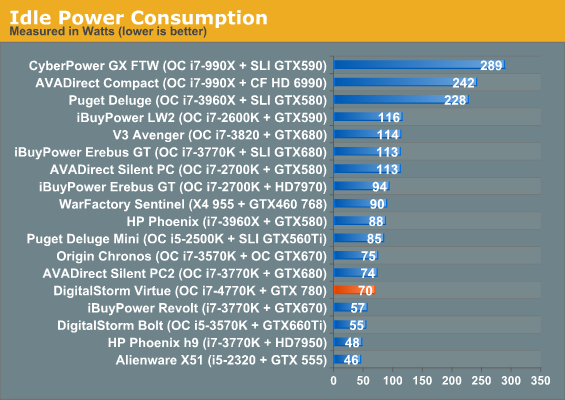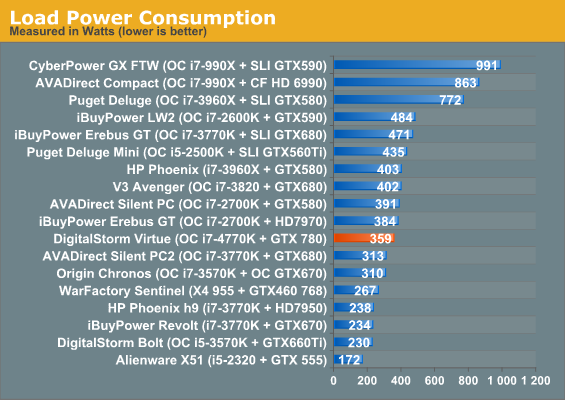Haswell and GK110 vs. Ivy and GK104: DigitalStorm Virtue System Review
by Dustin Sklavos on June 23, 2013 12:00 PM ESTBuild Quality
It's not entirely fair to DigitalStorm not to mention the generally excellent job they've done with the build quality of the Virtue. One of the ways a boutique can distinguish itself is in its component selection, and the stock component choices of the Virtue line are solid across the board.
Starting with the chassis selection, I'm actually a pretty big fan of the Corsair Obsidian 350D and I'm happy to see it being employed in a high performance system. Interestingly, DigitalStorm is also using Corsair's H100i to cool the CPU, but they're not employing Corsair Link software to control fan speed despite the system being wired to use it. Instead, the fans on the H100i (oriented beneath the radiator to pull in air from the top of the enclosure and then cycle it out of the rear exhaust) run at a fixed fan speed. I personally find variable fan speed to be distracting; I'd just as soon the whole system run silent all the time, end of discussion. DigitalStorm's choice here works for me.
.jpg)
The 350D also does an excellent job of showing off NVIDIA's reference cooler for the GeForce GTX 780, complete with the subtly glowing "GeForce GTX" logo. That's plugged into an ASUS Z87 Gryphon motherboard, and the system drive is a healthy 120GB Corsair Neutron GTX featuring an LAMD controller. Given all the Corsair kit in the Virtue, though, I'm actually surprised the memory is A-Data.
Where I'd be tempted to shake down DigitalStorm is in using a single stable voltage for overclocking the i7-4770K, but without more experience with Haswell and the quirks of its VRM I can't say if that's worth caring about or not. With the first generation chips (Nehalem, Clarksfield, Gulftown), this was a huge issue, but Sandy and Ivy were less problematic and it looks like Haswell is even less so. I do want to point out that DigitalStorm has traditionally been more aggressive about their CPU voltages than I'd like, but the i7-4770K's 1.28V is actually pretty common and totally reasonable.
Noise and Heat
Demonstrating a healthy amount of balance in their design, the Virtue isn't especially silent but is generally a touch quieter than enthusiast gaming desktops tend to be. Idle noise is around ~33dB, and since the CPU and chassis fans run at a fixed speed, the GeForce GTX 780 is really the only component that spins up or down. Unfortunately, while the 350D is an excellent case for liquid cooling, it does suffer slightly from Corsair's perpetual issues with middling air cooling performance.

Thermals on the GTX 780 are pretty par for the course, but it can jack noise levels up a couple of dB under sustained load. Meanwhile, the i7-4770K is really about where it needs to be. A more adventurous user might be able to eke a little more performance out of it with a little more juice, but I'd hesitate to push the H100i that much harder, especially without bumping the fan speeds up to a potentially uncomfortable volume.
Power Consumption
So how much power does a modern high end gaming system pull from the wall? The last couple of generations from Intel, NVIDIA, and AMD (Bulldozer/Piledriver notwithstanding) have all done an admirable job of continually reducing idle and load power consumption alike, so the DigitalStorm Virtue stands to benefit from those advances.


And it does. While neither one is abnormally spectacular, they're both totally reasonable. I'm not convinced DigitalStorm couldn't shave 10W or so off the idle power, but load power is where it ought to be.


_thumb.jpg)
_thumb.jpg)
_thumb.jpg)
_thumb.jpg)
_thumb.jpg)
_thumb.jpg)








70 Comments
View All Comments
wanderer000 - Sunday, June 23, 2013 - link
Anything and everything is a bit of a stretch there.p1esk - Sunday, June 23, 2013 - link
Well, let's just say I should have the widest possible range of components to choose from, that will fit into their design.Rick83 - Sunday, June 23, 2013 - link
The advantage is mostly in the hands-off warranty. As long as everything goes well, you're good building yourself, but I can imagine better ways to spend time and money, than to debug every component of my system, because I get odd bluescreens.p1esk - Sunday, June 23, 2013 - link
Did you even look at their warranty?Their default warranty covers defective components for 1 year, and if you want to extend it to 2 or 3 years, you pay $99 and $299 correspondingly. Pretty much every component you buy on Newegg has better warranty that this. So, basically, their warranty is a joke.
If you get an odd BSOD, you better know how to debug it (not rocket science, most issues relate to faulty RAM, which is easy to check), otherwise you will have to ship your system to them (and pay for shipping).
Honestly, I don't remember the last time I had problems with my builds, just buy quality components, read reviews, and chances of a problem will be tiny.
kuraegomon - Sunday, June 23, 2013 - link
The cost of paying a tech to build and burn-in the system, plus system warranty, isn't worth 10% over Newegg costs? Really? That's a very good margin from a customer point of view. If you don't like it, then don't pay it. By definition, if you're a confident enough builder and are willing to spare the time, you're not a target customer for boutique builders anyway.Note that I qualify on both fronts, so would never buy this system. However, I've also worked as a system builder and integrator, and from that viewpoint I think this system represents very good value.
p1esk - Sunday, June 23, 2013 - link
See my comment above about their warranty.Essentially, their value is assembly of components. For a technician who does it every day, it should not take more than 1 hour to assemble, overclock and test a system. That technician typically makes $15-25/hour.
So, again, what do they offer for the extra $200 they charge, which actually cost them $20?
JDG1980 - Sunday, June 23, 2013 - link
I think these kind of systems are aimed at gamers who aren't "enthusiasts" in the more general sense. Just because you like playing games on a PC doesn't mean you feel comfortable building a PC out of components, or even installing Windows from scratch. To you and I, those things are second nature, but most people can't do them.p1esk - Sunday, June 23, 2013 - link
Most gamers who are not "enthusiasts" will probably just go to Dell/HP website, or to their local BestBuy store, or ask their more knowledgeable friends for an advice on what to buy at Dell or BestBuy.When buying a new computer on their own, their choice will be primarily determined by brand awareness. DigitalStorm does not have any.
TheScottyB - Sunday, June 23, 2013 - link
DigitalStorm might not be as big as Dell or HP, but they've been doing well enough over the past 10 years to move into this facility four years ago: http://www.digitalstormonline.com/forums/facility-...They probably also have dedicated sales/accounts managers for maintaining a relationship with customers of their workstation products. This would let them avoid being dependent on the health of a single market.
And at a given price-point their machines have more value than a similarly-priced Dell or other global brand. They might not be the first brand in mind for a gamer, but any gamer who checks them out after seeing an article on a gaming news site will find a better machine for less. Whether or not they take the leap then depends on how much they trust the source. That's why sending machines to reviewers is so important to companies like DigitalStorm.
I don't work for a company exactly like DigitalStorm, but with regards to technician rates for custom builds or upgrades I get paid $15/hr but my employer charges either $60/hr or a flat fee based on the number and types of components. Whoever closed the sale also gets a small commission. From what I understand, a warranty extension for $99 is pretty typical of our competitors, but my employers charges more. However, we also offer warranty renewals if the customer allows us to perform a system checkup. There's a lot of overhead that eats into whatever the markup appears to be if you go strictly off the BOM.
Gigaplex - Monday, June 24, 2013 - link
1 hour is optimistic, running extended memtests and imaging the software etc takes time. A large OEM would run lots of these in parallel but boutiques don't get large volumes of orders so don't get those economies of scale.